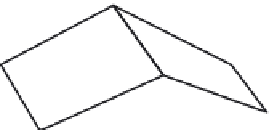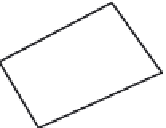Graphics Reference
In-Depth Information
*
i
i
Original dihedral angle
Bending along the edge that
changes dihedral angle
FIGURE 7.37
Control of bending by dihedral angle.
change the length of the edges or diagonal measurements. Bending can be controlled by either restrict-
ing the dihedral angles (the angle between adjacent quadrilaterals) or controlling the separation among
a number of adjacent vertices. A spring-type equation based on deviation from the rest angle can be
used to control the dihedral angle:
F
b
¼ k
b
? y
i
y
i
(
Figure 7.37
)
. Bending can also be controlled by
considering the separation of adjacent vertices in the direction of the warp and weft of the material
(
Figure 7.38
)
. See
Equation 7.91
for an example.
The mass-spring-damper system can then be updated according to basic principles of physics and
the cloth model can respond when subjected to external forces. Whether spring-like forces or energy
functions are used, the constants are globally and locally manipulated to impart characteristics to the
mesh. However, choosing appropriate constants can be an issue in trying to get a desired amount of
stretching, bending, and shearing.
For an effective cloth model, there are several issues that deserve special attention. First, the inte-
gration method used to update the physical model has an effect on the accuracy of the model as well as
on the computational efficiency. The computational efficiency is especially important in real-time sys-
tems. Second, a simple spring model can allow for unrealistic stretching of the cloth, referred to as
super-elasticity
. Cloth models typically use something other than the basic linear spring. Third, colli-
sion detection can be a large part of the computational effort in animating cloth. This is especially true
for clothes where the cloth is in near-constant contact with the underlying figure geometry. Fourth,
collision response has to be handled appropriately for the inelastic properties of cloth. Cloth does
not bounce away from collisions as much as it distorts, often taking the shape of the underlying surface.
Fifth, unlike a spring, cloth does not really compress. Instead, cloth bends, forming folds and wrinkles.
ð
Þ
l
1
l
2
l
1
v
2
v
2
v
2
l
2
v
3
v
2
v
1
v
3
l
3
v
3
v
1
l
3
FIGURE 7.38
Control of bending by separation of adjacent vertices.























Search WWH ::

Custom Search